Significant Battles in Marine Corps History
Briefly highlights the Battle of Badensburg, Battle of New Orleans, Battle of Belleau Wood, Battle of Wake Island, Guadalcanal, Tarawa, Marian Islands, Iwo Jima, Okinawa, Chosin Reservoir, Khe Sanh, and Hue City.
The BATTLE OF BADENSBURG: In January of 1814, 103 Marines and 400 Sailors made a vain attempt to block a force of 4,000 disciplined British troops from advancing on Washington. The Marines stopped three headlong charges before finally being over flanked and driven back. The British then moved down Bladensburg Road to Washington where they burned a number of public buildings before retiring to their vessels in the Chesapeake Bay.
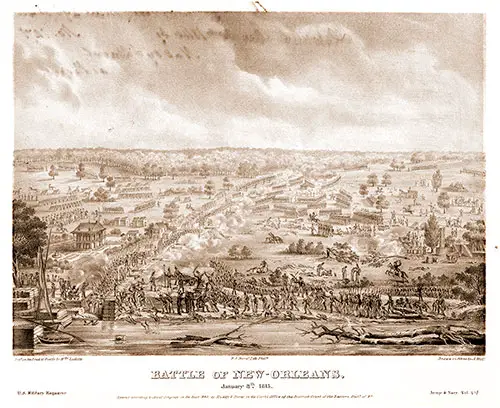
Battle of New Orleans - January 8, 1815 / desd. on the field of battle by Hthe. Laclotte ; drawn on stone by A. Hoffy ; P.S. Duval lith. Phila. Print shows a bird's-eye view of the battlefield showing troop alignments and barricades, with the river in the foreground. Library of Congress # 2012645333. GGA Image ID # 19a4c1aab3
The BATTLE OF NEW ORLEANS: In January of 1815, Marines under the command of General Andrew Jackson soundly defeated British Forces that ere attacking the city of New Orleans. The British lost approximately 2,000 men while American losses were less than 100.
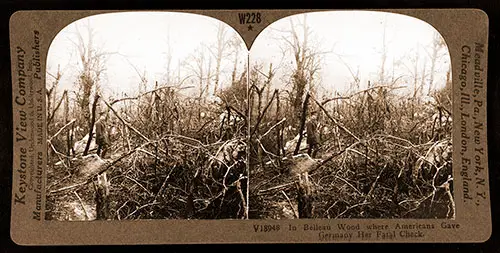
In Belleau Wood Where Americans Gave Germany Her First Fatal Check. Photographed Between 1914 and 1918, published 1923. © The Keystone View Company. Keystone Catalog No. V18948. Library of Congress # 2016646017 . GGA Image ID # 19a459aeba
V18948 In Belleau Wood Where Americans Gave Germany Her Fatal Check
It was in this dense tangle of trees and underbrush, slashed by storms of machine gun and rifle bullets and uprooted by shells, that the gallant Marine Brigade, of the 2nd Division, fought for a month and earned immortal glory for its name. Here these redoubtable fighters forced backward foot by foot some of Germany’s best troops and finally ousted them altogether from the wooded hill and hurled them back northward across the valley which we can see down yonder beyond the splintered tree branches.
Throughout the 30-mile front from Chateau-Thierry to the Aisne River west of Soissons (swâ'sôn'), the enemy was struggling desperately to approach nearer to Paris. Everywhere the veteran French troops eventually stopped them, but it seemed that their most sensational check was administered by the hitherto untried Americans of the 2nd and 3rd Divisions at Belleau Wood and Chateau-Thierry, where the invaders had most closely approached the French metropolis. Here, in a very real sense, the fortunes of Germany reached their high tide.
When they reeled back from Belleau Wood on July 18th before the furious attack of the 26th (“Yankee”) Division, which had relieved the 2nd in this sector, that tide of German fortune was beginning to ebb, and it continued to do so, more and more rapidly, until the final cataclysm which extinguished the hopes of German militarism on Nov. 11th, 1918.
Copyright by The Keystone View Company
The BATTLE OF BELLEAU WOOD: Marines fought one of their greatest battles in history at Belleau Wood, France during World War I. Marines helped to crush a German Offensive at Belleau Wood that threatened Paris. In honor of the Marines who fought there, the French renamed the area "the Wood of the Brigade of Marines." German intelligence evaluated the Marines as "storm troopers" --the highest rating on the enemy fighting scale. In reference to the Marine's ferocious fighting ability, German troops called their new enemy "Teufelhunden" or "Devildogs," a nickname in which Marines share pride.
The BATTLE OF WAKE ISLAND: In 1941, following the air attack on Pearl Harbor, the Japanese struck Wake Island on 8 December. Despite being heavily outnumbered, the Marines mounted a courageous defense before finally falling on 23 December. This small force of Marines caused an extraordinary number of Japanese casualties and damage to the invading force.
The vast majority of historic properties at Wake Island Atoll are significant for their association with the theme of World War II (WWII) in the Pacific. The cultural resources that remain are symbolic of the initial American defense, subsequent Japanese take-over, the travails of the American prisoners of war, and the ultimate defeat of the Imperial Japanese forces. Due to its unique location, Wake Island played a vital link in twentieth century civilian and military transportation networks before and during WWII, and was the site of pivotal battles won and lost, making it a significant WWII battlefield. The successful ability of the small contingent of U.S. military personnel and civilians at Wake to initially repel Japanese air attacks and a naval invasion within the first few days of the war was a critical step for the United States. Although defeated approximately two weeks later on December 23, 1941, when the Japanese eventually took over the island, this early small victory provided a tremendous boost to American morale in the face of great losses experienced at American installations in Hawai‘i, Guam, and elsewhere. During the nearly four-year Japanese occupation of Wake, American forces bombed and shelled the island, with major sorties taking place during October of 1943 and August of 1945, until the Japanese eventually surrendered Wake Island to the United States on September 4, 1945.
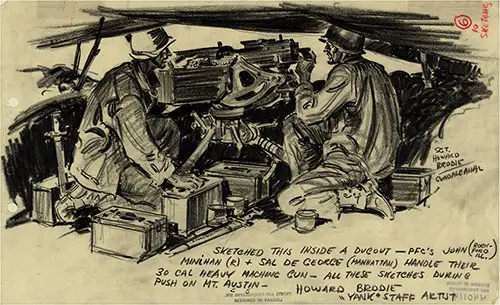
Drawing Shows Two Privates, John Minihan of Rockford, Illinois on the Right, and Sal De George of Manhattan on the Left, Kneeling to Operate a Machine Gun from Their Dugout during the American Offensive on Mt. Austen during the World War 2 Battle of Guadalcanal. Pfc's John (Rockford Ill.) Minihan (r) & Sal De George (Manhattan) Handle Their 30 Cal Heavy Machine Gun - All These Sketches during Push on Mt. Austin [i.e., Mt. Austen] - Howard Brodie "yank" Staff Artist. Library of Congress # 2004661741. GGA Image ID # 19a427c20d
The BATTLE OF GUADALCANAL: On 7 August 1942, the 1st Marine Division landed on the beaches of Guadalcanal in the Solomon Islands and launched the first United States land offensive of World War II. This battle marked the first combat test of the new amphibious doctrine, and also provided a crucial turning point of the war in the Pacific by providing a base to launch further invasions of Japanese-held islands. Amphibious landings followed on the remaining Solomon Islands including New Georgia, Choiseul (Feint), and Bougainville.
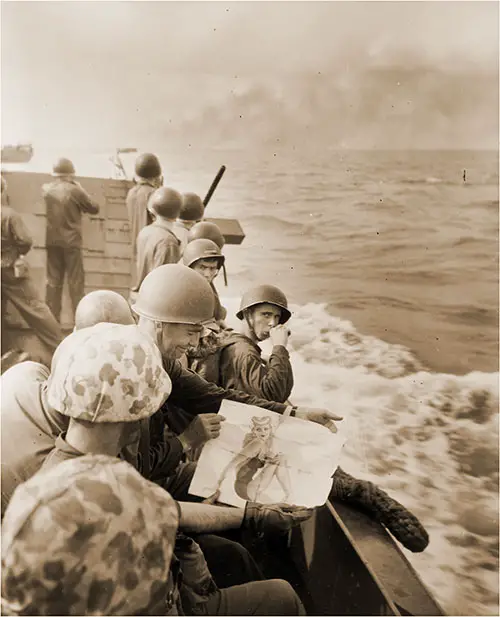
Where Marines go, their pin-ups go. Photograph shows American Marines on a landing barge approaching the Japanese-held island of Tarawa, Gilbert Islands, in the Pacific; one of the Marines shows at picture of pin-up girl to others. Tarawa burns in the background. Official U.S. Marine Corps photo. Library of Congress # 89715090. GGA Image ID # 19a40780a2
The BATTLE OF TARAWA: The Gilbert Islands were the first in the line of advance for the offensive in the Central Pacific. The prime objective was the Tarawa Atoll and Betio Island which had been fortified to the point that the Japanese commander proclaimed that it would take a million Americans 100 years to conquer it. On 20 November 1943, Marines landed and secured the Island within 76 hours, but paid a heavy price in doing so. Because of an extended reef, landing craft could not cross it and Marines were offloaded hundreds of yards from the beaches. This led to heavy losses from enemy fire. Additionally, many Marines drowned while attempting to wade ashore.
The BATTLE OF THE MARIAN ISLANDS: Due to the need for airfields by the Air Force and advanced bases for the Navy, the Marianas were invaded. Landings on the islands of Saipan, Guam, and Tinian accomplished this. During June and July of 1943, Lieutenant General Holland M. Smith led a combined invasion force of Marines and Soldiers that totaled over 136,000. This was the greatest number of troops up to that time to operate in the field under Marine command.
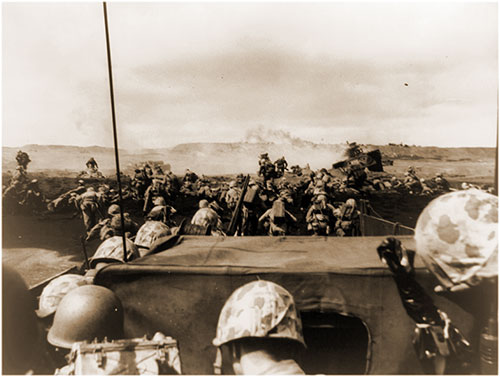
A Wave of Charging Fourth Division Marines Begin an Attack from the Beach at Iwo Jima, 19 February 1945, on D-day as Another Boatload of Battle-tested Veterans Is Disgorged on the Beach by an Invasion Craft. Photograph by U.S. Marine Corps. Library of Congress # 96506979. GGA Image ID # 19a3e335b8
The BATTLE OF IWO JIMA: On 19 February 1945, Marines landed on Iwo Jima in what was the largest all-Marine battle in history. It was also the bloodiest in Marine Corps history. The Marine Corps suffered over 23,300 casualties. The capture of Iwo Jima greatly increased the air support and bombing operations against the Japanese home islands. Of the savage battle Admiral Chester W. Nimitz said, "Among the Americans who served on Iwo Island, uncommon valor was a common virtue."
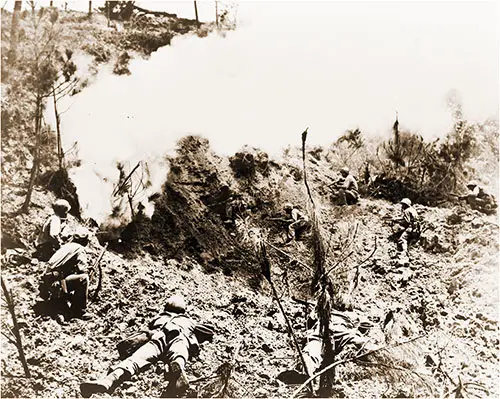
Trapped--rifle Sights Lined on the Entrance to an Okinawan Cave, Marines Await the Results of an Explosive Charge to Pick off Any Japs Who Attempt to Escape. These Bitterly Contested Cave Positions Formed the Japanese "little Siegfried Line," Defending the Capital City of Naha. Marine Corps. Photo. Library of Congress # 94505538. GGA Image ID # 19a3ced46e
The BATTLE OF OKINAWA: In April of 1945, Marines and Soldiers landed and secured the island of Okinawa. This marked the last large action of World War II. Due to the death of the Army commander, Major General Roy S. Geiger assumed command of the 10th Army and became the only Marine officer ever to have commanded a field Army.
The BATTLE OF THE CHOSIN RESERVOIR: After pushing far into North Korea during November of 1950, Marines were cut off after the Chinese Communist Forces entered the war. Despite facing a 10-divison force sent to annihilate them, Marines smashed seven enemy divisions in their march from the Chosin Reservoir. The major significance of the retrograde movement was that Marines brought out all operable equipment, properly evacuated their wounded and dead, and maintained tactical integrity. General Smith made a famous quote that stated: "We are not retreating, we are attacking in a different direction
The SECOND BATTLE OF KHE SANH: In January of 1968, Marines defended the firebase at Khe Sanh from an attack force of two North Vietnamese Army (NVA) divisions. Despite heavy bombardment, the Marines held out for over two and half months before finally forcing the enemy forces to withdraw.
The BATTLE OF HUE CITY: During the Vietnamese holiday of Tet in January of 1968, Communist forces launched a surprise offensive by infiltrating large numbers of their troops into the major population centers of Hue City, South Vietnam. A near division-size unit of NVA troops occupied the city of Hue and the Citadel. Marines fought in built-up areas for the first time since the Korean War foregoing the application of heavy arms to minimize civilian casualties. Fighting was house-tohouse with progress measured in yards. The city was secured on 25 February 1968.
"Significant Battles in Marine Corps History, " in RP 0105 - USMC History and Traditions, pp. 5-8
